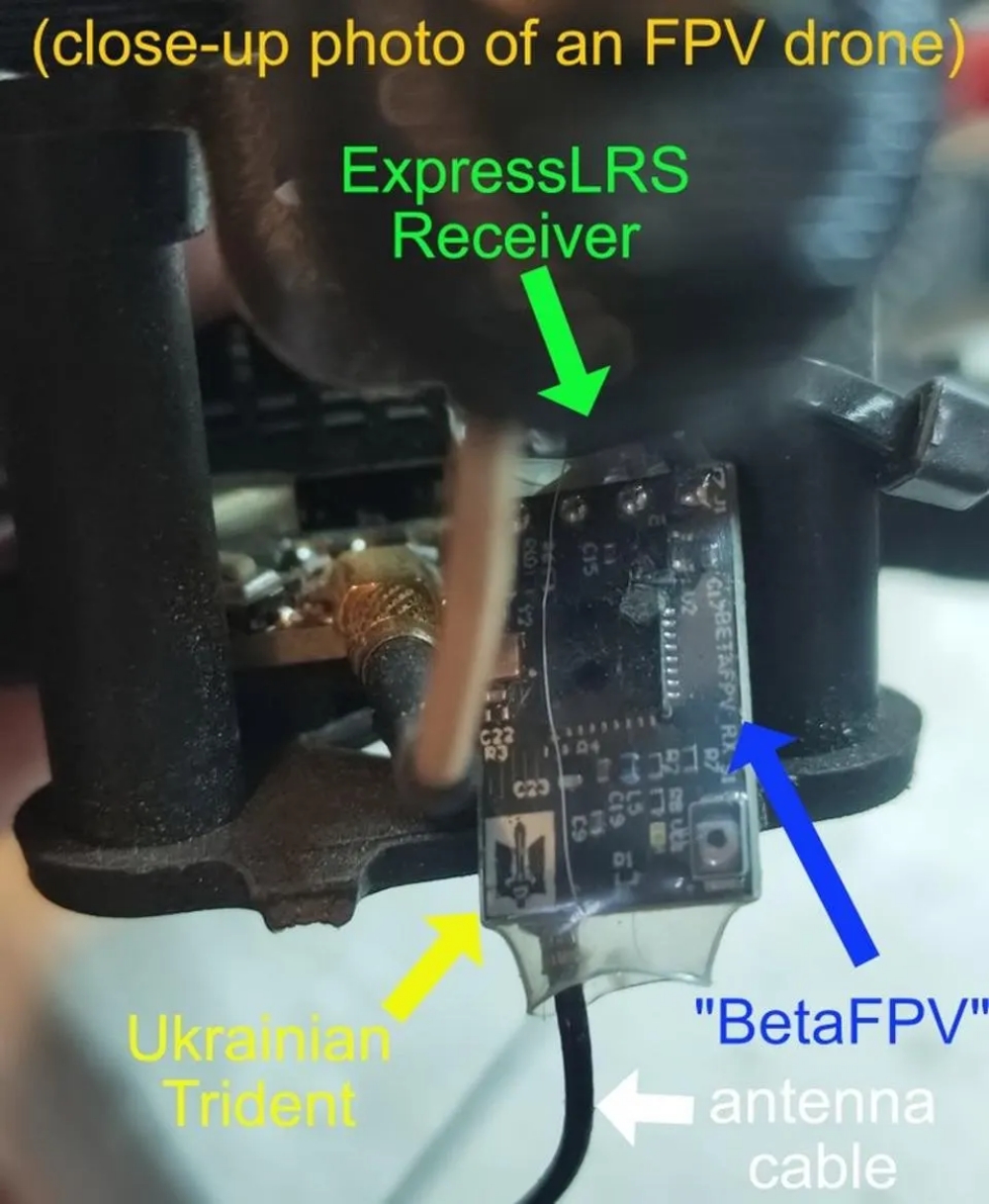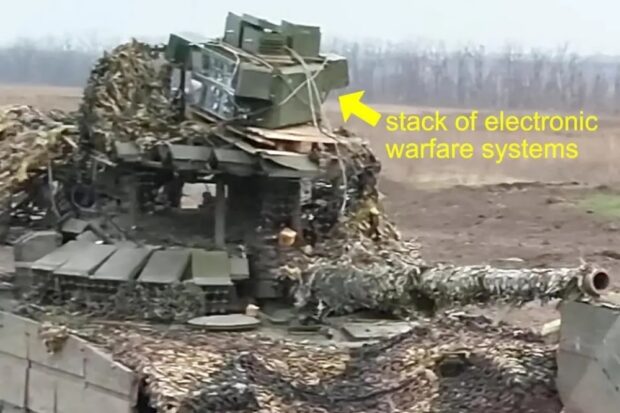Radio-frequency jamming is currently the best protection against drones. In order to work, it has to broadcast noise on the same frequency band that enemy drones are using to communicate. Of course drone operators keep changing the frequencies they use, and jammers have to keep changing to stay effective.
The alternate approach would be to just jam all the frequencies, all the time?
That is exactly that the Russians did.
It did not go well.
Monster Jammer Stack
As a rule one jammer can only handle one frequency band at a time. For example, the popular Breakwater (“Volnorez”) Russian jammer, which is the size of a dinner plate and stuck on the outside of a tank with magnets, can be set to block one of twenty different frequency ranges. Breakwater knocks out any drone using that particular frequency from two hundred meters away, making the vehicle immune to FPV attacks on that band.
Get the wrong frequency though and the drone just flies right through and destroys your tank. That means you have to know which is currently in use by the enemy, or pack your vehicle with twenty different jammers.
This was the idea behind a new Russian ‘Frankentank’ described by Ukrainian electronic warfare expert Sergii Flash which led an attacking column last week. Like most Russian tanks it had a roof screen, but on that roof screen was a wooden pallet piled high with electronic warfare gear.
“It was like something from Mad Max,” Flash wrote on his Telegram channel. “On the pallet, the Russians piled up a monstrous structure with everything they had. There are three panels of patch antennas 800/900/2.4/5.8 around the circle, and blocks for 700-1000 bands were added to all of this. From above on some boards, and in a circle. All this was tied with ropes. “
A jammer only works when it has a power source though. And while some modern Russian tanks have auxiliary power units, many do not. That means that when the tank engine is turned off, the jammer stops working. But the Russians had thought of that.
“A generator and battery were also installed,” says Flash.
Ukrainian scout drones spotted the Russian armored column and FPV attack drones flew out to strike it. But the jammers did their work.
“Our FPVs were dropping like flies at all frequencies,” says Flash.
One report suggests that four FPVs were lost before the fifth one got through and disabled the monster jammer tank.
“It [destroying them] was easier with the rest of the column,” says Flash.
How to Beat Jamming
Obviously the Ukrainians are not telling us just how they managed to get through the wall of jamming, but there are a number of possibilities.
It might have been something exotic kept in reserve for just this sort of target. Both sides have deployed FPV drones which do not rely on radio communications but spool out a fiber-optic cable to communicate through. These have shorter range than radio-controlled versions but are immune to jamming. Only a few examples have been seen so far though.
Or it might have been one of the new FPV drones with automatic lock-on which Ukraine has started to field in larger numbers. These drones have a machine vision system which allows the operator to designate a target as soon as they spot it. The drone stays locked on to that target and will continue to fly towards it until impact, even if it loses the radio connection with the operator. This technology was developed partly to negate the effects of jamming, but also to reduce the demand for skilled FPV pilots.
There is another way. DanielR, a physicist who follows drone tech in the Ukraine conflict, recently spotted images of an FPV drone with an unusual component, a radio communicator which looked like a standard ExpressLRS receiver but for one small detail.
“It seems to have a Ukrainian Trident symbol, strongly suggesting it is custom made,” DanielR noted on Twitter/X. “ The only reason for this would be to avoid EW [Electronic Warfare] by operating at a non-standard frequency… Changing the drone’s receiver frequency can make the EW much less effective.”

This radio receiver carries the the Ukrainian nation symbol, indicating it was made locally DANIEL R
Ukraine is increasingly making its own components to reduce its reliance on Chinese imports. This also means they can change specification and use frequency bands which are not normally associated with drones.
The Recovery Mission
So far this looks like another story of Russian brute-force engineering being defeated by Ukrainian technical ingenuity. But there is a surprising sequel.
The monster jammer tank was not destroyed but only put out of action. After it was hit the driver lost control, the tank got tangled in some wire and crashed into a destroyed personnel carrier. It came to a halt and the crew quickly baled out and ran away.
The Ukrainians saw that the tank was virtually intact and decided to recover it.
Even though the tank was only 400 meters from Russian lines, over three nights the Ukrainian troops from the Azov division went out, removed the wire tangling up with wheels, defused an anti-tank mine which was almost underneath the vehicle, and two men carried out a 60 kilo /130-pound battery to get it restarted. Then they drove the tank back to their own lines. There’s a full video of the recovery mission here:
Як проходила операція по захопленню танка разом з царь-РЕБ бійцями бригади
«Азов»?
В тому бою висувалась підарська танкова колона, яка була знищена, а от «царь-танк» прожив трішки довше, адже зупинився лише після пошкодження FPV-дроном (пошкодив систему керування вогнем) +
pic.twitter.com/xgwTSUR8Ch
— Serg (@NHunter007) April 7, 2024
Reportedly, all those involved with the mission, which captured the first ever T-72B3M mod. 2022 to be recovered, were decorated.
And presumably Ukrainian technicians have uncovered the secrets of the monster jammer and will be working out ways to defeat it next quicker next time.
Meanwhile the Russians are working on other ways to protect their tanks, like covering them with complete turtle-like shells, but those do not seem to be working out either.
Source: Forbes


